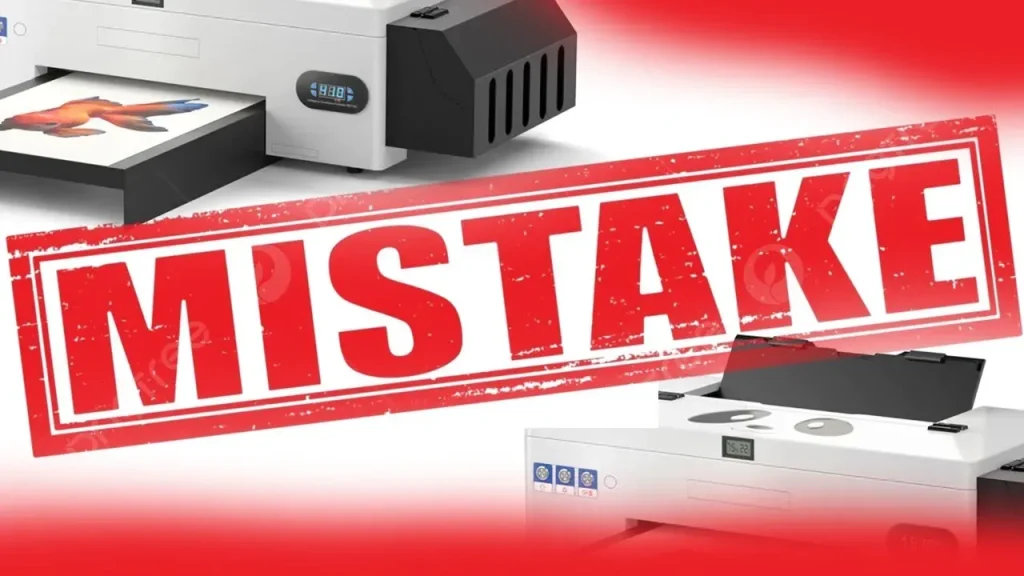DTF Printing Mistakes can significantly impact the quality of your finished garments, making it crucial for budding printers to recognize and learn from these common pitfalls. Newcomers often encounter issues related to improper file preparation, inadequate pre-treatment, and incorrect ink settings, leading to frustrating results. To ensure a smooth printing process, it’s essential to implement effective DTF printing troubleshooting techniques that address these common DTF printing errors. By understanding best practices for DTF printing and actively seeking DTF printing solutions, you can avoid costly mistakes and enhance your output quality. This guide aims to help you navigate the complexities of DTF printing and provide you with actionable steps to improve your skills and results.
In the world of garment customization, Direct-to-Film (DTF) printing has risen to prominence as an efficient method for transferring intricate designs onto fabrics. However, many individuals face challenges that stem from missteps in their printing practices or misunderstandings of the technology. Whether you’re dealing with film transfer mistakes or experiencing issues with adhesion, recognizing and addressing these miscalculations is key to streamlining your production process. By employing alternatives in DTF print methodologies and staying informed on troubleshooting approaches, you’ll not only enhance your print quality but also maximize the longevity of your designs. Let’s delve deeper into some of the prevalent problems encountered in DTF printing and the effective solutions to mitigate them.
Common DTF Printing Errors and Their Impact
DTF printing is a remarkable technology that allows for vibrant and durable prints on various fabrics. However, many users face challenges that can stem from common DTF printing errors. One prevalent mistake is using incorrect file formats or settings that don’t cater to DTF printing specifics. For instance, using RGB color mode instead of CMYK can lead to color inaccuracies that do not reflect the intended design when printed. This oversight can result in wasted materials and diminished quality in the final product.
Another common error that arises is the failure to adequately prepare files for printing. Low DPI settings can lead to blurry images, which may not be apparent until the final print is produced. Ensuring that artwork is prepared with the correct resolution is crucial for achieving the sharpness and clarity that DTF printing promises. By addressing these common errors, users can avoid significant pitfalls that hinder their printing outcomes.
Best Practices for DTF Printing Efficiency
To maximize efficiency in DTF printing, understanding and implementing best practices is vital. This includes preparing your files meticulously by ensuring they are in the correct color mode and resolution. Using vector graphics whenever possible helps maintain the integrity of the design during the printing process. Furthermore, exploring the specifications of different fabrics will enable you to select the best ink settings and pre-treatment options, enhancing the print’s durability and vibrancy.
Another best practice is to conduct test prints prior to full production runs. Test prints not only allow you to evaluate the design on the actual material but also enable troubleshooting potential issues early in the process. By previewing the final product before committing to mass production, you can fine-tune your settings and avoid costly errors, ensuring quality finishes every time.
DTF Printing Troubleshooting: Identifying Key Issues
Effective DTF printing troubleshooting requires a keen eye for potential issues that can derail the printing process. Often, inadequate pre-treatment can lead to poor ink adhesion, resulting in discolored or peeling prints. This is a critical issue that many users overlook, yet it is an essential step in ensuring the longevity of the print. By familiarizing yourself with the manufacturer’s pre-treatment recommendation and conducting thorough tests, you can significantly mitigate these problems.
Another vital aspect of troubleshooting is understanding the machine settings, including ink density and nozzle configurations. Incorrect settings can cause ink to splatter or lead to inconsistent prints. By regularly checking and calibrating your printer settings to match the type of fabric being used, you not only enhance print quality but also reduce downtime due to troubleshooting. Identifying these key issues efficiently is crucial for maintaining a smooth printing workflow.
Avoiding DTF Printing Mistakes with Proper Maintenance
One of the leading causes of poor quality in DTF printing is neglecting the maintenance of your printer. Regular cleaning of print heads and ink lines is essential in preventing clogs that can compromise print quality. Users should adhere to a maintenance schedule as outlined by the manufacturer, which generally includes routine inspections and cleaning. This proactive approach ensures that your printer operates at peak efficiency, ultimately leading to better print outcomes.
Additionally, developing good maintenance habits not only extends the life of your printer but also reduces the likelihood of encountering common DTF printing mistakes that stem from equipment failure. By investing time in maintaining your printer, you save resources and time that would be spent on reprints and repairs due to negligence.
Understanding Temperature and Pressure Settings in DTF Printing
Managing temperature and pressure settings is crucial for achieving optimal DTF print quality. Incorrect heat press settings can result in under-cured or over-cured prints, which directly affects the durability and appearance of the transfer. It is important to consult the heat press manufacturer’s recommendations and regularly check settings based on the type of fabrics used for printing, as varying materials may require different approaches.
Correct pressure settings are equally important; applying too much or too little pressure can lead to incomplete transfers or damaged prints. Utilizing a reliable heat press with adjustable parameters allows for the necessary fine-tuning. By prioritizing these settings and making informed adjustments, you can enhance the quality and consistency of your DTF printing results.
Post-Printing Handling: Best Practices for Longevity
Post-printing handling is a critical phase that often gets overlooked in the DTF printing process. Proper care after the transfer has been made can significantly impact the longevity and integrity of the print. Allowing the prints to cool completely before handling is essential, as this prevents distortion and maintains the design’s alignment. Mishandling the garment—such as stretching or folding it too soon—can lead to unsatisfactory results that may require reprinting.
Furthermore, it is advisable to educate team members about the specific protocols for handling printed items. Creating a standard operating procedure for post-printing handling ensures consistency and protects your investment in time and resources. By emphasizing these practices, you increase the chances of producing high-quality garments that stand the test of time.
Frequently Asked Questions
What are the common DTF printing errors I should be aware of?
Common DTF printing errors include improper file preparation, inadequate pre-treatment, incorrect ink settings, mismanagement of temperature and pressure, post-printing handling mistakes, and neglecting cleaning protocols. Identifying these pitfalls early can help you avoid costly mistakes and improve print quality.
How can I troubleshoot issues in DTF printing?
To troubleshoot DTF printing issues, first review your file preparation to ensure correct settings, check the pre-treatment application, verify ink settings, and adjust heat press temperature and pressure. Additionally, maintain your printer regularly and always conduct test prints to catch potential errors before mass production.
What are the best practices for DTF printing to avoid mistakes?
Best practices for DTF printing include using high-resolution CMYK files, applying even pre-treatment, setting accurate ink and heat press parameters, handling prints carefully post-transfer, and performing regular printer maintenance. Incorporating these practices can lead to higher quality prints and fewer mistakes.
How do I avoid DTF printing mistakes related to file preparation?
To avoid DTF printing mistakes in file preparation, make sure to convert your artwork to CMYK color mode and use a resolution of at least 300 DPI. Consider using vector graphics for better quality, and always double-check your files for any inconsistencies before printing.
What should I do if my DTF prints are peeling or discolored?
If your DTF prints are peeling or discolored, it is likely due to inadequate pre-treatment or incorrect heat settings. Reassess your pre-treatment application to ensure even coverage and verify that your heat press settings meet the recommended temperature and pressure for the material being used.
Is it necessary to perform test prints in DTF printing?
Yes, performing test prints in DTF printing is crucial to ensure color accuracy and print quality. Test prints allow you to make necessary adjustments before beginning large runs, helping to avoid unexpected results and reducing waste in materials.
| Mistake | Description | Solution |
|---|---|---|
| Improper File Preparation | Neglecting correct color mode or low DPI settings. | Always set to CMYK with at least 300 DPI. Use vector graphics. |
| Inadequate Pre-Treatment | Skipping or poorly applying pre-treatment resulting in bad adhesion. | Follow manufacturer’s guidelines for even coverage. |
| Incorrect Ink Settings | Wrong nozzle configurations or ink density leading to poor print quality. | Adjust settings according to fabric using the printer’s user manual. |
| Temperature and Pressure Mismanagement | Inaccurate heat press settings leading to under/over-curing. | Keep heat press around 320°F (160°C) and check pressure settings. |
| Post-Printing Handling Errors | Stretching or folding prints too soon causing distortions. | Allow prints to cool before handling to preserve integrity. |
| Ignoring Cleaning Protocols | Neglecting printer maintenance leading to clogs. | Implement a regular cleaning schedule according to manufacturer’s guidelines. |
| Not Performing Test Prints | Skipping test prints leading to unexpected final results. | Always conduct test prints to check colors and quality. |
Summary
DTF printing mistakes can significantly impact the quality of your output. Understanding these common errors and actively working to avoid them is pivotal in enhancing your printing process. By applying best practices such as meticulous file preparation, proper pre-treatment application, and maintaining regular cleaning protocols, you can ensure high-quality results. Engaging in test printing before mass production also plays a critical role in achieving the desired final product. Staying informed about DTF printing solutions and advancements can further support your success in this creative field.



